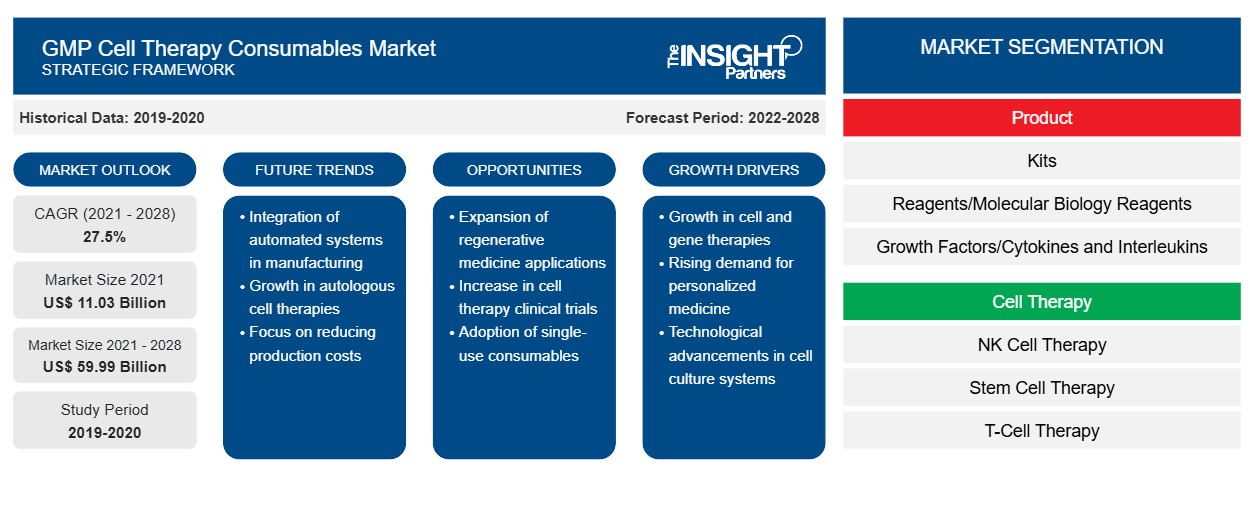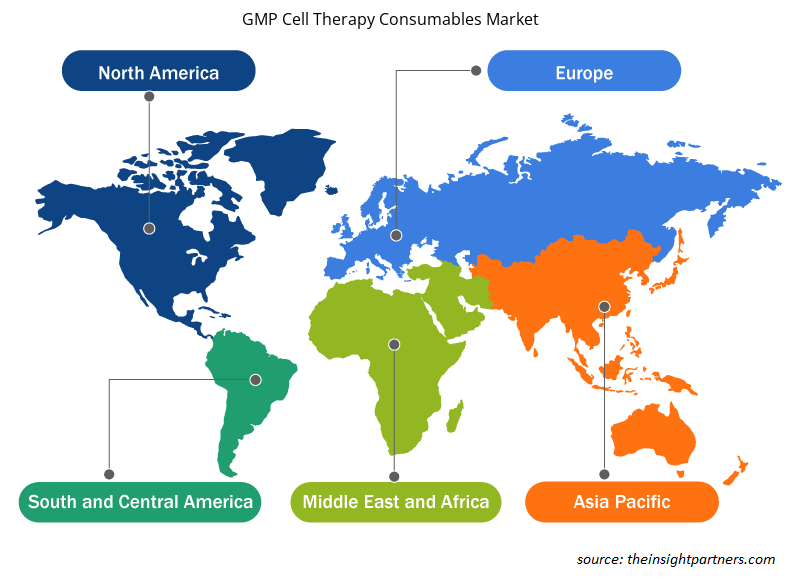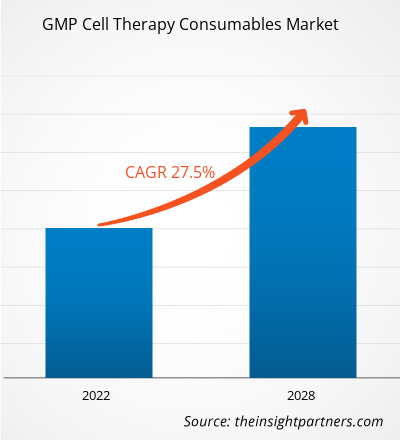Der Markt für GMP-Verbrauchsmaterialien für die Zelltherapie soll von 11.031,25 Millionen US-Dollar im Jahr 2021 auf 59.985,89 Millionen US-Dollar im Jahr 2028 wachsen; von 2022 bis 2028 wird mit einer durchschnittlichen jährlichen Wachstumsrate von 27,5 % gerechnet.
Der Markt für GMP-Verbrauchsmaterialien für die Zelltherapie ist nach Produkt, Zelltherapie, Verfahren, Endverbrauch und Regionen segmentiert. Der Bericht bietet Einblicke und eine eingehende Analyse des Marktes und hebt dabei verschiedene Parameter wie Dynamik, Trends und Chancen des Marktes sowie eine Wettbewerbslandschaftsanalyse führender Marktteilnehmer in verschiedenen Regionen hervor. Er enthält auch die Auswirkungsanalyse der COVID-19-Pandemie auf die Regionen.
Markteinblicke
Anstieg in Forschung und Entwicklung sowie Arzneimittelentdeckung treiben Marktwachstum an
Die Arzneimittelentdeckung ist ein langer Prozess, der verschiedene Schritte umfasst, wie etwa die frühe Entdeckung, die präklinische Phase, die klinische Phase und die behördliche Zulassung. Der Prozess erfordert in hohem Maße den Einsatz von Verbrauchsmaterialien für die Zelltherapie, um die gewünschten Ergebnisse zu erzielen. Laut der Weltgesundheitsorganisation wurden im Jahr 2020 etwa 10 Millionen Todesfälle aufgrund von Krebs verzeichnet, und die häufigsten Krebsarten sind Brust-, Lungen-, Dickdarm-, Mastdarm- und Prostatakrebs. Verschiedene Forschungsstudien haben positive Ergebnisse von Medikamenten gezeigt, die Krebs, neurologische Störungen, Autoimmunerkrankungen und andere chronische Erkrankungen wirksam behandeln können. Daher treibt die steigende Prävalenz chronischer Erkrankungen die Nachfrage nach Forschungs- und Entwicklungsaktivitäten (F&E) voran.
Darüber hinaus arbeiten zahlreiche auf dem Markt tätige Biotechnologieunternehmen zusammen, um die F&E-Aktivitäten auf globaler Ebene zu beschleunigen. So gaben Century Therapeutics und Bristol Myers Squibb im Oktober 2022 die Forschungskooperation und Lizenzvereinbarung zur Entwicklung und Vermarktung von bis zu vier aus induzierten pluripotenten Stammzellen („iPSC“) gewonnenen, künstlich erzeugten natürlichen Killerzellen („iNK“) und/oder T-Zellen („iT“) für hämatologische Malignome und solide Tumore bekannt. Darüber hinaus hat die steigende Nachfrage nach personalisierter und regenerativer Medizin das Wachstum des Marktes für Verbrauchsmaterialien für die Zelltherapie weiter angekurbelt. Eine Zunahme der Arzneimittelentdeckung und F&E erfordert gute Herstellungspraktiken, und um die gewünschten Ergebnisse dieser Aktivitäten zu erzielen, sind GMP-Verbrauchsmaterialien erforderlich. Daher hat eine Zunahme der Forschungs- und Entwicklungsaktivitäten zusammen mit einem Anstieg der Arzneimittelentdeckung den Einsatz von GMP-Verbrauchsmaterialien für die Zelltherapie erhöht.
Markt für GMP-Verbrauchsmaterialien für die Zelltherapie –
Passen Sie diesen Bericht Ihren Anforderungen an
Sie erhalten kostenlos individuelle Anpassungen an jedem Bericht, einschließlich Teilen dieses Berichts oder einer Analyse auf Länderebene, eines Excel-Datenpakets sowie tolle Angebote und Rabatte für Start-ups und Universitäten.
Markt für GMP-Verbrauchsmaterialien für die Zelltherapie: Cell Therapy Consumables Market: Strategische Einblicke

-
Holen Sie sich die wichtigsten Markttrends aus diesem Bericht.Dieses KOSTENLOSE Beispiel umfasst eine Datenanalyse von Markttrends bis hin zu Schätzungen und Prognosen.
Produktbasierte Einblicke
Basierend auf dem Produkt ist der Markt für GMP-Verbrauchsmaterialien für die Zelltherapie in Kits, Reagenzien/ molekularbiologische Reagenzien , Wachstumsfaktoren/Zytokine und Interleukine und andere unterteilt. Im Jahr 2021 hatte das Kits-Segment den größten Marktanteil. Es wird jedoch erwartet, dass das Segment Wachstumsfaktoren/Zytokine und Interleukine zwischen 2022 und 2028 die höchste CAGR auf dem Markt verzeichnet. Reagenzien und Ergänzungsmittel, die speziell für die Zellkultur entwickelt wurden, ermöglichen das Wachstum und die Vermehrung eines breiten Spektrums von Zelltypen unter kontrollierten Bedingungen. Die Produkte von TheraPEAK umfassen eine Reihe von GMP-Puffern und Reagenzien, die für die Erstellung und Entwicklung von Zell- und Gentherapien bestimmt sind. Sie werden hauptsächlich in ISO: 13485-Anlagen hergestellt, sodass diese GMP-Lösungen für die Zell- und Gentherapie von verschiedenen Kunden in zahlreichen klinischen Anwendungen verwendet werden. Es kann verschiedene Arten von molekularbiologischen Reagenzien geben, die von Natur aus GMP-konform sind und hauptsächlich in akademischen und klinischen Umgebungen verwendet werden.GMP cell therapy consumables market is segmented into kits, reagents/interleukins, and others. In 2021, the kits segment held the largest market share. However, the growth factors/cytokines and interleukins segment are anticipated to register the highest CAGR in the market during 2022–2028. Reagents and supplements specifically designed for cell culture allow the growth and propagation of a wide spectrum of cell types under controlled conditions. TheraPEAK Products include an array of GMP buffers and reagents dedicated to the creation and development of cell and gene therapies. They are mainly produced in ISO: 13485 plants, such that these GMP solutions for cell and gene therapy are used by various customers in numerous clinical applications. There can be various types of molecular biology reagents that are GMP compliant in nature and mainly used in academics and clinical settings.
Zelltherapiebasierte Erkenntnisse
Basierend auf der Zelltherapie ist der Markt für GMP-Verbrauchsmaterialien für die Zelltherapie in NK-Zelltherapie, Stammzelltherapie, T-Zelltherapie und andere unterteilt. Im Jahr 2021 hielt das Segment der T-Zelltherapie den größten Marktanteil. Es wird jedoch erwartet, dass der Markt im Segment der NK-Zelltherapie im Prognosezeitraum am schnellsten wächst. Die chimäre Antigenrezeptor-(CAR)-T-Zelltherapie ist eine Immuntherapie zur Behandlung bestimmter Krebsarten, insbesondere Blutkrebs oder Leukämie. Die Therapie nutzt die Kraft des Immunsystems, das vor Infektionen und Krankheiten schützt, indem es schädliche Eindringlinge wie Viren und Bakterien zerstört. Zur Krebsbehandlung werden verschiedene Forschungs- und klinische Studien zur CAR-T-Zelltherapie durchgeführt. So wurde im Januar 2022 von Forschern des University College London (UCL) eine neue CAR-T-Zelltherapie entwickelt. Klinische Phase-I-Studien dieser Therapie, die an den UCL Hospitals (UCLH) durchgeführt wurden, kamen zu dem Schluss, dass diese Therapie weniger toxische Wirkungen hat und dauerhaft ist. Solche zunehmenden klinischen Studien zur CAR-T-Zelltherapie lassen die Nachfrage nach GMP-Verbrauchsmaterialien für die Zelltherapie steil ansteigen.
Prozessbasierte Erkenntnisse
Basierend auf dem Prozess ist der Markt für GMP-Verbrauchsmaterialien für die Zelltherapie segmentiert in Zellsammlung und -charakterisierung/-sortierung und -trennung, Zellkultur und -expansion/-vorbereitung, Kryokonservierung, Zellverarbeitung und -formulierung, Zellisolierung und -aktivierung, Zellverteilung/-handhabung, Prozessüberwachung und -kontrolle/-nachverwaltung/Qualitätssicherung und andere. Im Jahr 2021 hielt das Segment Zellsammlung und -charakterisierung/-sortierung und -trennung den größten Marktanteil. Es wird jedoch erwartet, dass der Markt für GMP-Verbrauchsmaterialien für die Zelltherapie im Segment Kryokonservierung im Prognosezeitraum am schnellsten wächst. Die Zellcharakterisierung ist entscheidend für das Verständnis der intrinsischen Faktoren, die an der Zellproliferation, -funktion und dem Gesamtprozess beteiligt sind. Zellen werden anhand dieser Eigenschaften sortiert und getrennt. Unternehmen bauen GMP-konforme Zellsortierer, um Verunreinigungen während des Prozesses zu vermeiden. Beispielsweise verkauft Miltenyi Biotec den MACSQuant Tyto Cell Sorter, eine sterile und GMP-konforme multiparametrische Zellsortierung in einem geschlossenen Kartuschensystem. Das Unternehmen stellt außerdem ein Analysezertifikat (CoA), ein Herkunftszertifikat (CoO) und Produktinformationsdateien (PIF) für die behördliche Genehmigung von Zellherstellungsprotokollen bereit.
Endverbrauchsbasierte Erkenntnisse
Basierend auf der Endverwendung ist der Markt für GMP-Verbrauchsmaterialien für die Zelltherapie in Klinik, Handel und Forschung unterteilt. Im Jahr 2021 hielt das klinische Segment den größten Marktanteil. Außerdem wird erwartet, dass der Markt für GMP-Verbrauchsmaterialien für die Zelltherapie im selben Segment im Prognosezeitraum am schnellsten wächst. Im klinischen Einsatz wird Zelltherapieforschung an Menschen durchgeführt, um medizinische, chirurgische oder verhaltensbezogene Eingriffe einer bestimmten Therapie zu bewerten. Klinische Studien werden aufgrund der steigenden Prävalenz chronischer Erkrankungen, der zunehmenden Zahl von Biologika und der steigenden Zahl von Auftragsforschungsinstituten, die klinische Studien durchführen, ausgeweitet. Verschiedene Zelltherapien werden voraussichtlich in den kommenden Jahren eine Marktzulassung erhalten. Laut einem Artikel in Nature befanden sich im April 2021 2.073 aktive Zelltherapiemittel in der Pipeline, das sind 572 mehr als im Update von 2020.
Die Marktteilnehmer für GMP-Verbrauchsmaterialien für die Zelltherapie verfolgen organische Strategien wie Produkteinführung und -erweiterung, um ihre Präsenz und ihr Produktportfolio weltweit zu erweitern und der wachsenden Nachfrage gerecht zu werden. Anorganische Wachstumsstrategien, die auf dem Markt zu beobachten sind, sind Partnerschaften und Kooperationen. Diese Wachstumsstrategien haben es den Marktteilnehmern ermöglicht, ihre Geschäfte auszuweiten und ihre geografische Präsenz zu verbessern. Darüber hinaus tragen Übernahmen, Partnerschaften und andere Wachstumsstrategien dazu bei, den Kundenstamm des Unternehmens zu stärken und sein Produktportfolio zu erweitern.
Regionale Einblicke in den Markt für GMP-Zelltherapie-Verbrauchsmaterialien
Die regionalen Trends und Faktoren, die den Markt für GMP-Zelltherapie-Verbrauchsmaterialien während des gesamten Prognosezeitraums beeinflussen, wurden von den Analysten von Insight Partners ausführlich erläutert. In diesem Abschnitt werden auch die Marktsegmente und die Geografie von GMP-Zelltherapie-Verbrauchsmaterialien in Nordamerika, Europa, im asiatisch-pazifischen Raum, im Nahen Osten und Afrika sowie in Süd- und Mittelamerika erörtert.

- Erhalten Sie regionale Daten zum Markt für GMP-Zelltherapie-Verbrauchsmaterialien
Umfang des Marktberichts zu GMP-Verbrauchsmaterialien für die Zelltherapie
| Berichtsattribut | Details |
|---|---|
| Marktgröße im Jahr 2021 | 11,03 Milliarden US-Dollar |
| Marktgröße bis 2028 | 59,99 Milliarden US-Dollar |
| Globale CAGR (2021 - 2028) | 27,5 % |
| Historische Daten | 2019-2020 |
| Prognosezeitraum | 2022–2028 |
| Abgedeckte Segmente |
Nach Produkt
|
| Abgedeckte Regionen und Länder |
Nordamerika
|
| Marktführer und wichtige Unternehmensprofile |
|
Marktteilnehmerdichte für GMP-Verbrauchsmaterialien für die Zelltherapie: Auswirkungen auf die Geschäftsdynamik verstehen
Der Markt für GMP-Verbrauchsmaterialien für die Zelltherapie wächst rasant. Dies wird durch die steigende Nachfrage der Endnutzer aufgrund von Faktoren wie sich entwickelnden Verbraucherpräferenzen, technologischen Fortschritten und einem größeren Bewusstsein für die Vorteile des Produkts vorangetrieben. Mit der steigenden Nachfrage erweitern Unternehmen ihr Angebot, entwickeln Innovationen, um die Bedürfnisse der Verbraucher zu erfüllen, und nutzen neue Trends, was das Marktwachstum weiter ankurbelt.
Die Marktteilnehmerdichte bezieht sich auf die Verteilung der Firmen oder Unternehmen, die in einem bestimmten Markt oder einer bestimmten Branche tätig sind. Sie gibt an, wie viele Wettbewerber (Marktteilnehmer) in einem bestimmten Marktraum im Verhältnis zu seiner Größe oder seinem gesamten Marktwert präsent sind.
Die wichtigsten Unternehmen auf dem Markt für GMP-Verbrauchsmaterialien für die Zelltherapie sind:
- Sartorius AG
- Thermo Fisher Scientific Inc
- Miltenyi Biotec BV & Co KG
- Bio-Techne Corp
- Corning Inc
Haftungsausschluss : Die oben aufgeführten Unternehmen sind nicht in einer bestimmten Reihenfolge aufgeführt.

- Überblick über die wichtigsten Akteure auf dem Markt für GMP-Zelltherapie-Verbrauchsmaterialien
- Im Januar 2021 unterzeichnete Sartorius eine strategische Kooperation mit RoosterBio Inc., einem führenden Anbieter von humanen mesenchymalen Stamm-/Stromazellen (hMSC). Die Kooperation hat die Skalierung der hMSC-Herstellung für die regenerative Medizin vorangetrieben. RoosterBio und Sartorius erstellten eine Reihe GMP-kompatibler, kundenorientierter Protokolle unter Verwendung der hMSC- und Mediensysteme von RoosterBio sowie der Einweg-Herstellungstechnologien, Prozesssteuerungssoftware und Zellanalysetools von Sartorius für die Herstellung des hMSC-Endprodukts.
- Im September 2020 eröffnete die Bio-Techne Corporation eine hochmoderne Produktionsanlage mit einer Fläche von ca. 5600 Quadratmetern, die den Good Manufacturing Practices (GMP) entspricht. Die neue Anlage in St. Paul, Minnesota, ist auf die Produktion von Materialien in GMP-Qualität im großen Maßstab ausgerichtet, die ein wesentlicher Bestandteil vieler Arbeitsabläufe für zell- und genmodifizierte Therapien in der Immunonkologie und regenerativen Medizin sind. Diese Anlage hilft dem Unternehmen, die aktuelle und zukünftige Nachfrage nach Reagenzien in GMP-Qualität zu decken, die zur Unterstützung des schnell wachsenden Zelltherapiemarktes erforderlich sind.
Markt für GMP-Verbrauchsmaterialien für die Zelltherapie – Firmenprofile
- Sartorius AG
- Thermo Fisher Scientific Inc
- Miltenyi Biotec BV & Co KG
- Bio-Techne Corp
- Corning Inc
- FUJIFILM Irvine Scientific Inc
- Lonza Group AG
- BPS Bioscience Inc
- Merck KGaA
- Global Life Sciences Solutions USA LLC.
- Historische Analyse (2 Jahre), Basisjahr, Prognose (7 Jahre) mit CAGR
- PEST- und SWOT-Analyse
- Marktgröße Wert/Volumen – Global, Regional, Land
- Branchen- und Wettbewerbslandschaft
- Excel-Datensatz
Aktuelle Berichte
Verwandte Berichte
Erfahrungsberichte
Grund zum Kauf
- Fundierte Entscheidungsfindung
- Marktdynamik verstehen
- Wettbewerbsanalyse
- Kundeneinblicke
- Marktprognosen
- Risikominimierung
- Strategische Planung
- Investitionsbegründung
- Identifizierung neuer Märkte
- Verbesserung von Marketingstrategien
- Steigerung der Betriebseffizienz
- Anpassung an regulatorische Trends






















 Kostenlose Probe anfordern für - Markt für GMP-Verbrauchsmaterialien für die Zelltherapie
Kostenlose Probe anfordern für - Markt für GMP-Verbrauchsmaterialien für die Zelltherapie